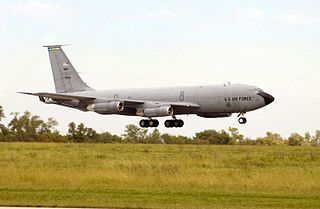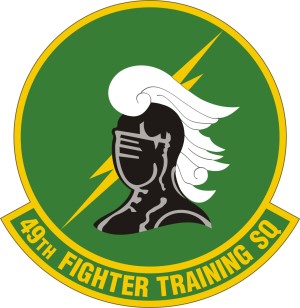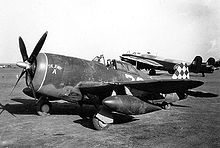
The Lockheed F-94 Starfire is a first-generation jet powered all-weather day/night interceptor aircraft designed and produced by Lockheed Corporation. It was the first operational United States Air Force (USAF) fighter equipped with an afterburner as well as being the first jet-powered all-weather fighter to enter combat during the Korean War.

Hamilton Field was a United States Air Force base, which was inactivated in 1973, decommissioned in 1974, and put into a caretaker status with the Air Force Reserve until 1976. It was transferred to the United States Army in 1983 and was designated an Army Airfield until its BRAC closure in 1988. It is located along the western shore of San Pablo Bay in the southern portion of Novato, in Marin County, California.

Larson Air Force Base is a former United States Air Force base located five miles (8 km) northwest of the central business district (CBD) of Moses Lake, in Grant County, Washington. After its closure in 1966, the airport facility became Grant County International Airport.

The 117th Air Refueling Squadron is a unit of the Kansas Air National Guard 190th Air Refueling Wing located at Forbes Field Air National Guard Base, Topeka, Kansas. The 117th is equipped with the Boeing KC-135R Stratotanker.

The 95th Fighter Squadron, nicknamed the Boneheads, is an active squadron of the United States Air Force. Last activated on 15 June 2023 as a Lockheed Martin F-35 squadron stationed at Tyndall Air Force Base, Florida. Previously the 95 FS was an F-22 equipped squadron, but in 2019 the squadron's aircraft and personnel were distributed across other bases in the aftermath of Hurricane Michael in 2018 and its destruction of large parts of Tyndall Air Force Base. It was subsequently disbanded in 2019. In August 2023, the unit received its first Lockheed Martin F-35A Lightning II aircraft.

The 114th Fighter Squadron is a unit of the Oregon Air National Guard 173d Fighter Wing located at Kingsley Field Air National Guard Base, Klamath Falls, Oregon. The 114th is equipped with the McDonnell Douglas F-15C Eagle.

The 49th Fighter Training Squadron is part of the 14th Flying Training Wing based at Columbus Air Force Base, Mississippi. It operates T-38 Talon aircraft conducting flight training.

The 317th Fighter Interceptor Squadron is an inactive United States Air Force unit, last assigned to Aerospace Defense Command, at Elmendorf Air Force Base, Alaska, where it was inactivated on 31 December 1969.

The 318th Fighter Interceptor Squadron is an inactive United States Air Force unit. Its last assignment was with the 25th Air Division at McChord Air Force Base, Washington, where it was inactivated on 7 December 1989.

The 325th Fighter-Interceptor Squadron is an inactive United States Air Force unit, last assigned to Air Defense Command at Truax Field, Wisconsin, where it was inactivated on 25 June 1966.
The 4706th Air Defense Wing is a discontinued United States Air Force (USAF) organization. Its last assignment was with the 37th Air Division of Air Defense Command (ADC) at O'Hare International Airport (IAP), Illinois where it was discontinued in 1956. It was established in 1952 at O'Hare as the 4706th Defense Wing in a general reorganization of Air Defense Command (ADC), which replaced wings responsible for a base with wings responsible for a geographical area. It assumed control of several Fighter Interceptor squadrons that had been assigned to the 142d Fighter-Interceptor Wing, an Air National Guard wing mobilized for the Korean War and the 56th Fighter-Interceptor Group. In early 1953 it also was assigned six radar squadrons in the Midwest and its dispersed fighter squadrons combined with colocated air base squadrons into air defense groups. The wing was redesignated as an air defense wing in 1954. It was discontinued in 1956 and most of its units transferred to the 58th Air Division.
The 4703d Defense Wing is a discontinued United States Air Force organization. Its last assignment was with Air Defense Command (ADC)'s Western Air Defense Force at Larson Air Force Base (AFB), Washington. It was established in 1952 in a general reorganization of Air Defense Command (ADC), which replaced wings responsible for a base with wings responsible for a geographical area. It then assumed control of several Fighter Interceptor squadrons that had been assigned to the 101st Fighter-Interceptor Wing, which was an Air National Guard unit mobilized for the Korean War. The wing's 569th Air Base Group briefly assumed the host responsibility for Larson, but the wing and group were inactivated only 45 days later when Larson became a Tactical Air Command base. The wing's units were transferred to the nearby 4702d Defense Wing.

The 33d Operations Group is the flying component of the 33d Fighter Wing, assigned to Air Education and Training Command of the United States Air Force. The group is stationed at Eglin Air Force Base, Florida.

The 566th Air Defense Group is a disbanded unit of the United States Air Force. Its last assignment was with the 28th Air Division at Hamilton Air Force Base, California, where it was inactivated on 18 August 1955. The group was originally activated as the 566th Air Service Group, a support unit for a combat group at the end of World War II but never deployed before it was inactivated in 1945.

The 325th Operations Group is the flying component of the 325th Fighter Wing, assigned to Air Combat Command of the United States Air Force. The group is stationed at Tyndall Air Force Base, Florida. It conducts training on the Lockheed Martin F-22 Raptor and commands one operational Raptor squadron. It directs the flying and support operations of two F-22 squadrons, a fighter training squadron, an operations support squadron and a training support squadron.

The 319th Operations Group is a United States Air Force unit assigned to 319th Reconnaissance Wing, Air Combat Command. It is stationed at Grand Forks Air Force Base, North Dakota operating RQ-4 Global Hawk remotely piloted aircraft (RPA) in the intelligence, surveillance and reconnaissance (ISR) role.

The 348th Reconnaissance Squadron is an active United States Air Force squadron, assigned to the 319th Operations Group. It was activated at Grand Forks Air Force Base, North Dakota on 19 September 2011. It currently operates the RQ-4 Global Hawk, High Altitude Intelligence, Surveillance, and Reconnaissance Remotely Piloted Aircraft.

The 509th Tactical Fighter Squadron is an inactive United States Air Force unit. It was last assigned to the 10th Tactical Fighter Wing at RAF Alconbury, England, where it was inactivated on 30 December 1992.

The 123d Fighter Squadron is a unit of the Oregon Air National Guard 142d Fighter Wing located at Portland Air National Guard Base, Oregon. The 123d is equipped with the McDonnell Douglas F-15C Eagle and Boeing F-15EX Eagle II.

The 172nd Attack Squadron is a unit of the Michigan Air National Guard 110th Wing located at Battle Creek Air National Guard Base, Battle Creek, Michigan. The 172nd is equipped with the MQ-9 Reaper drone.






























